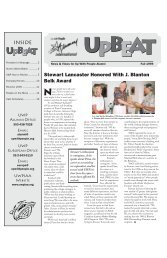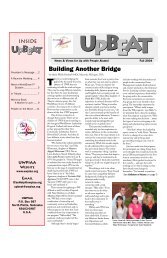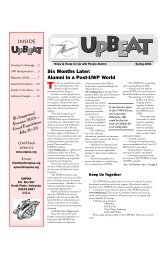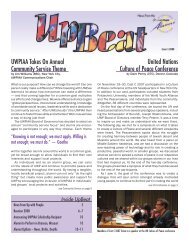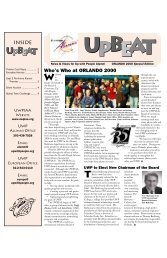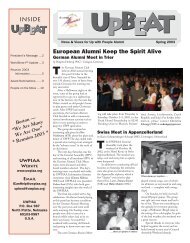UWPIAA Prepares for New LeadershipApril 1, 2008 marks a day of transitionby Christine Geißler (91B), Frankfurt, Germany, UWPIAA PresidentThe Board of Governors has votedfor Vickie Henthorn Law to becomepresident of the UWPIAA in April 2009.Vickie traveled in various casts from1966–1968 and currently resides inKnoxville, Tennessee. Besides volunteeringfor the UWPIAA, she works as afreelance consultant and editor in themedical field. In 2006, Vickie joinedthe BOG as an era representative. Shecurrently chairs the Board RecruitmentCommittee. We are excited to continuethe leadership of the association withsuch experienced hands and congratulateVickie on this election!April 1, 2008, also marked the endof past leadership. Sary Garcia (77A),who served first as an era representative,then secretary and president, hascompleted her term as immediate pastpresident. Please join me in extendingmy deepest gratitude for the seven-plusyears of service that Sary has dedicatedto the UWPIAA.As the current president of the UWPIAA,it has been an honor to learn from andwork with Sary Garcia, and I am nowlooking forward to passing on the torchto Vickie in April next year.Health & Wellness Updateby Jim Williams (86C), New York CityIn UpBeat <strong>Issue</strong> 1 2008, we presentedthe UWPIAA community service themefor this year: Health and Wellness.We hope that as many alumni aspossible have had a chance to participatein their own way — in findingways to promote healthy living in theirown lives, families and communities.Please send your idea, story, tributeor question to communications@uwpiaa.<strong>org</strong>.One great resource — for informationand inspiration — is the EuropeanPublic Health Alliance, which promotesand protects the health of all peopleliving in Europe and advocates f<strong>org</strong>reater participation of citizens inhealth-related policy making (epha.<strong>org</strong>). The Healthier US Initiative has awebsite that provides ideas for peopleIn additionto the leadershipchanges,a number ofn e w f a c e shave joinedthe BOG thisterm: BruceHarris (75C)UWPIAA President ElectVickie Henthorn Lawas Development chair, Dana Seidel(97E) as 1996-2000 era rep, GodyRetchkiman (75B) as Latin Americanrep, Grant Axton (87A) as 1986-1990era rep, Greg Fritz (84E) as 1981-1985 era rep, Madoka Tatsuno (00D)as Asia-Pacific rep, Mona CarrandiBowe (87E) as Admissions chair,Robert Blake (68C) as 1965-1970era rep, Sebastian Hesse (00E) asEurope-MidEast-Africa rep, and WillieKnowles (70B) as 1971-1975 erarep. The 26 BOG volunteers currentlyrepresent eight different countriesand span from the original Sing Outcasts to the WorldSmart era. If you areinterested in volunteering your talents,ideas and energy for the UWPIAA,please contact recruitment@uwpiaa.<strong>org</strong> for further information.to incorporate more physical activity intheir lives, eat healthier foods, protectthemselves from illness and avoidhealth risks (healthierus.gov). If youknow of a similar resource in otherregions, please email communications@uwpiaa.<strong>org</strong>.Also, don’t f<strong>org</strong>et about “mental”fitness. The Canadian Mental HealthAssociation (cmha.ca) reminds us that“when we are mentally healthy, weenjoy our life and environment, and thepeople in it. We are better able to copewith difficult times in our personal andprofessional lives.Nurturing our mental health canalso help us combat or prevent themental health problems that aresometimes associated with a chronicphysical illness. Managing stresswell, for instance, can have a positiveimpact on heart disease.” So giveYou Can Help a SouthAfrican Tribal YouthTravel with UWPIn an effort to extend the opportunity totravel with UWP to someone who wouldotherwise never have the chance,the UWPIAA and UWP are launchingan unprecedented effort to raise fullscholarships for young people fromcountries where the annual income ismeasured in just hundreds of dollars.The first beneficiary will be eithera Zulu, Pedi, Xhosa or Basotho youthfrom South Africa. This has beenfacilitated by UWPIAA BOG memberBob Blake and his Sing Out friendsfrom the late 1960s (see article atright). On youtube.com you can evenwatch them interviewing some of thepotential candidates under the title“Harambe in South Africa.” Harambeis Swahili and means “pull together.”In order to make this a reality, weneed your help. At firstgiving.com/uwpsowetoscholarship you can makea secure online donation with any creditcard — and leave a message for thelucky student. You can also send adonation to UWPIAA, PMB 466, 17011Lincoln Ave., Parker, CO 80134. Pleasenote it as “South Africa Scholarship.”For a full scholarship, we need toraise $20,000. This will cover UWPtuition, travel, passport, visas and otherexpenses, including clothing, suitcase,etc. If every alumnus gave just a fewdollars or euros, we could change thefuture of one African tribal youth forever— and it will enrich the experience forall the other cast members and hostfamilies around the world too.When have you had the chance tochange someone’s life in such a positiveway for the price of a cup of coffee?Please, everyone, make room atthe table.yourself permission to step away fromtasks at hand and recharge your batteriesfor at least a few minutes eachday. Allow yourself to daydream — andstop multi-tasking — remember positivepast moments, enjoy hobbies, setpersonal goals, share humor — andtreat yourself well.8 UpBeat
A Poor Outlook for a Rich CultureAn eye-opening journey through South Africaby Dr Bob Blake (68C), Blenheim, New ZealandDuring a recent visit to South Africa and Mozambique, myview of the world as I knew it changed forever; it gave me adeeper and, I hope, genuine appreciation for the countriesthat are struggling for their everyday existence, and how theseissues relate to the goals of UWP.One of the reasons for the trip was to interview possiblesponsors for assistance with indigenous tribal youth who wishto bring their rich culture, music and dances — for the firsttime — into UWP. More specifically, those are the villages ofthe Zulu (the famous warrior nation that defeated the Britisharmy in battle); the Basotho (from the mountain kingdom ofLesotho with their skillful horsemanship); the Xhosa (NelsonMandela’s tribe from the coastline of the Eastern Cape); andthe Pedi (with their unusual architecture, horn whistles andgreat drums).As these tribal peoples merged into Johannesburg to workin the mines, some found themselves living in Soweto (SouthWest Township). The poverty and poor living conditions of theinhabitants of Soweto are now legendary, and when wevisited, there was a celebration because a freshwater tap— yes, just one — had been installed at the end of a longrow of houses. Downtown Johannesburg is abandonednowadays, and the electricity and water have been turnedoff; it has become a darkened city of illegal immigrants andeven the police stay away from the former downtown area.To add to this grim outlook, the official government reportsstate that there are approximately 5,000 illegal immigrants— each day — walkinginto South Africaacross the desert bordersof Zimbabwe,Namibia, Botswanaand Mozambique.Bob Blake (68C), UWPIAA Era Rep 1965-1970, is greeted by Zulu youth inJanuary 2008.During our trip, we visited several Zulu villages where theyouth were caretakers for African endangered animals. Theydemonstrated their cultural dances, and we were blown awayat the magic of their rhythm and naturally choreographedancestral stories. Seated on the dirt floor inside the large,dark ceremonial hut, I will never f<strong>org</strong>et ... It was like the NewZealand “Haka” gone mad — with large knives and raw-hideshields crashing against each other, just inches from our faces!And with few cell phones, walkmans, gameboys and othergadgets that jerk people away from eye-to-eye, heart-to-heartcommunication, it was evident that the young Zulu don’t have,what I call, the “fidget syndrome” — at least not yet ...How the youth of the Zulu could benefit from the UWP experiencetruly is not the question; after spending time with them,the question we need to ask ourselves is, “How can UWPbenefit from Zulu participation?”Above, left to right: Simon, a 23-year-old possible UWP recruit if he can obtain enoughfinancial assistance. Soweto children with Bob Blake after celebration of installation of thevillage’s only water tap in December 2007. Zulu youth demonstrate their ancient tribal wardances for Blake.At left: William de Toit (67B) and Blake meet in Cape Town, South Africa, as part of Blake’sattempts to reengage lost alumni from his era from Southern Hemisphere countries.UpBeat 9



